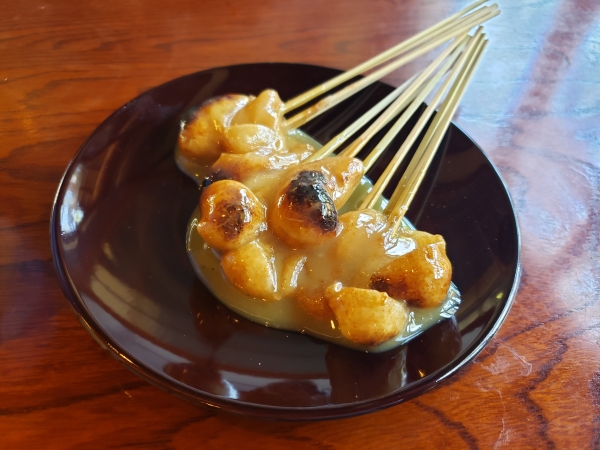Aburi mochi: Food for the gods now served to you

Enclosing the path leading up to the gates of Imamiya Shrine (今宮神社 Imamiya-jinja) in Kyoto Prefecture (京都府 Kyōto-fu) is a shop called Ichimonya Wasuke (一文字屋和輔). In fact, this is the only mochi (餅 rice cake) store that lines both sides of a shrine path as one of its unique features. The history of this shop overlaps with that of the nearby shrine that was actually built to ward off an epidemic in the year 1000. Ichimonya is often advertised as one of the very few 1,000-year-old shops in the world, but the reality is a bit different. This reporter sat down with the owner to discuss its history, significance in Kyoto City (京都市 Kyōto-shi), and of course to eat some delicious aburi mochi (あぶり餅).

(Image credit: Ilse Montald)
While mochi is now a staple for the Japanese people, it was not consumed by the general population until Japan entered the relatively peaceful Edo period (1600–1868). Rice was precious, and polishing it pure white, even more. As such mochi was reserved for the wealthy but most importantly, for the gods. Especially in Kyoto, the ancient capital, it became common for shops to start selling mochi near the shrine for worshippers. Ichimonya made mochi exclusively to be offered to the gods, but in 1637 they opened another store, Kazariya (かざりや), on the opposite side of the shrine entrance. While they are both under the same ownership and you can now sit on either side, there is still a clear distinction between the mochi for the shrine gods and the mochi on your plate.

(Image credit: Ilse Montald)
As Kyoto has many shrines, mochi sellers started competing with each other for the best flavour. Major shrines such as Yasaka Shrine (八坂神社 Yasaka-jinja) and Shimogamo Shrine (下鴨神社 Shimogamo-jinja) started selling yakimochi (やきもち baked mochi) now commonly served with a bean paste filling. Imamiya had a different plan and decided to use white miso (白味噌 shiro miso) that had a natural sweetness to it combined with kinako (きな粉 roasted soybean flour). The small bite-sized pieces of mochi are pierced on a small bamboo skewer and roasted over charcoal. They are then coated in the white miso sauce and served with a refreshing cup of tea.

(Image credit: Ilse Montald)
Because of its connection with Imamiya Shrine, the aburi mochi is commonly eaten to ward off diseases and protect from disasters. For this reason, Kazariya allows visitors to take home mochi to give it to family members or friends as a prayer for good health. Takeout mochi is only possible from a portion of three but their small size and amazing flavour will surely leave you craving for more. The next time you are in Kyoto, why don’t you try this unique mochi that can only be found here in one of the oldest shops in the world?
Imamiya Shrine (今宮神社)
Address: Imamiya-cho, Murasakino, Kita-ku, Kyoto-shi, Kyoto 603-8243
Opening hours: 9am–5pm (Closed on Wednesdays)
Admission fee: Free
Aburi mochi: ¥500
Tel: +81-75-491-9402
Header image credit: Ilse Montald





